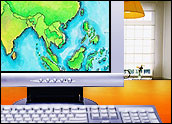
Enterprise application integration (EAI) services will emerge as the biggest opportunity in the Asia-Pacific IT marketplace, excluding Japan, between now and 2011, according to a forecast by Springboard Research.
Defined as “the integration (typically across varied platforms and applications) of an enterprise’s applications, such as finance and accounting and customer relationship management (CRM),” Springboard forecasts the EAI market in A-P will grow at a compound annual rate of 11.5 percent between 2007 and 2011, from US$5 billion to $7.8 billion.
The forecast is part of “Asia Pacific IT Services Market and Forecast 2006-2011,” which Springboard released May 20, in which it identifies and ranks the top 10 IT services markets in the A-P region on the basis of growth opportunities.
“Enterprise and infrastructure application integration services are the two most attractive markets in Asia Pacific’s services space,” said Phil Hassey, vice president, services research, for Springboard. “Both have high levels of growth and an increasingly sophisticated customer base, and clearly score higher than enterprise IT outsourcing, which is being outpaced in growth terms as a market opportunity when compared to other markets.”
Top 10 Market Opportunities
Overall, the IT services market in the A-P region will reach $55.9 billion by 2011, Springboard forecasts.
Evaluating 15 different A-P IT services markets according to the Springboard Market Attractiveness Index to identify the best growth opportunities, Springboard came up with the following top 10:
- Enterprise application integration
- Infrastructure application integration
- Infrastructure support services
- Network integration
- Custom application development
- Enterprise IT outsourcing
- Application hosting
- IT consulting
- Application management
- Infrastructure hosting services
Looking at vendor activity in the region, SAP has been particularly strong, Hassey told the E-Commerce Times. “SAP based consultants are still at a premium in a number of ways.”
A combination of vendor push and client pull is driving IT services market trends, he commented. “Oracle and SAP need to sell licenses; Accenture and IBM need to feed large machines of consultants — as do other players — and the market has a demand to ensure that enterprises remain competitive — there is a genuine integration of reasons. Enterprises are generally strong and smart enough to make their own investment decisions; they do not take the providers’ word that something needs to be done.”
Enterprise Application Integration
EAI spending will outpace and in sum surpass enterprise IT outsourcing — the largest market opportunity in the A-P region at present — during the five-year period. Growth in enterprise IT outsourcing will slow to 7 percent constant annual growth rate (CAGR) during the period, the lowest of all markets researched.
“In general, it is a link to the increased maturity of IT in the region. Infrastructure expenditure, whilst still happening, is making way in relative terms for investment in applications to sit over the infrastructure,” Hassey explained.
“At the same time, infrastructure is commoditizing at an increased rate to application investments. As a result the cost per unit to undertake activity has declined more rapidly. It is not that infrastructure is going anywhere, but the apps side is growing even faster,” he said.
EAI growth isn’t uniform in depth, scope or scale across the region, he continued. “For example, ANZ (Australia/New Zealand) and Singapore are even further down the path, but there is a broad shift in the move to apps.”
In terms of application types, the business intelligence (BI), though small, is growing. CRM, along with knowledge platform integration, are two other key application market segments.
Application and Infrastructure Services
Springboard forecasts that A-P’s application hosting and infrastructure hosting IT services market sector will be the fastest-growing between 2007 and 2011, registering 19 percent and 16.3 percent CAGRs, respectively.
The broader infrastructure services group will continue to be the largest single component, 57 percent, of the Asia-Pacific IT Services marketplace, reaching $31.6 billion in 2011.
“Domination of this infrastructure services market is the target for HP following its acquisition on May 13th of EDS. It will be very strongly positioned in this marketplace and will create significant discomfort across the competition in this marketplace”, Hassey noted.
Application services will be the fastest-growing group, however. Spending in A-P’s application services market group grew 35 percent in 2007, totaling $13.3 billion, and is forecast to continue growing at a 12.2 percent CAGR out to 2011, reaching $21.2 billion.
“It is equally important to note that all markets are growing at varying degrees. Each year, in dollar value, the growth of the enterprise application integration services market is between 1.5 and 2 times the size of the total application hosting space,” Hassey pointed out. “This data highlights the need to still focus on the big markets, because while in some instances the growth is not spectacular, the market size information shows the available opportunity and subsequent resources that are required for success.”
Country and Industry Views
Examining the IT services market in individual countries, India is the fastest growing, followed by China, according to Hassey and Springboard.
“In absolute terms — annual dollar growth — Australia and Korea are still very, very important in the marketplace. Indonesia, the Philippines and Vietnam are fast-growing, but coming off such a low base that in the scheme of things the big four of India, China, Australia and Korea are the key markets,” he added.
Looking vertically across business and industrial sectors, the financial services and telecommunications industries, unsurprisingly, are under competitive pressures and investment scenarios that dictate expenditure.
“Increasingly, we are seeing verticals such as retail and transportation/distribution increase investment in the current environment to either chase growth, or to ensure that they are able to meet the growth environment. Retail in China and distribution in the Australian resources sector are two examples of industries that are under extraordinary growth pressures at the current time frame,” Hassey commented.
Parallels in the US Market
The trend toward increased spending on EAI — business intelligence, CRM and knowledge management — in A-P parallels trends in the U.S.
“Our customers’ business challenges and organizations are becoming increasingly complex. So on the technology side, they need to simplify. They need to have either fewer applications or — more realistically — a better way to put the applications they need within better reach for their employees,” commented Dean Hager, senior vice president of product management at Lawson Software.
“This means providing an information workspace where employees access the specific apps or functions that they use in their day-to-day activities. Our customers don’t want to have their employees to have to move in and out of applications — doing task A in Excel, task B in their enterprise system and task C in a yet another system — particularly when the data being used is linked to all of these tasks. On top of this, customers are demanding meaningful business intelligence capabilities that can cut across applications enterprise-wide,” he added.
Aiming to address these needs, Lawson in March unveiled Lawson Smart Office, which it bills “as an intuitive, personalized user interface that allows users to directly access Lawson and Microsoft applications and update data pervasively and instantly across the applications.”





















































Social Media
See all Social Media